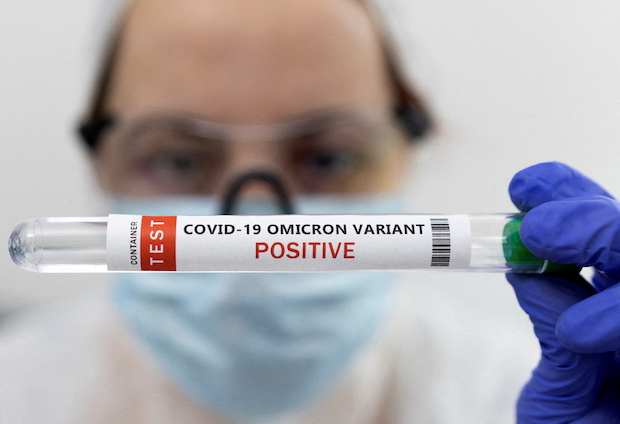
Test tube labeled “COVID-19 Omicron variant test positive” is seen in this illustration picture taken Jan. 15, 2022. (REUTERS/Dado Ruvic/Illustration/File Photo)
COPENHAGEN — The BA.2 subvariant of the Omicron coronavirus variant, which has quickly taken over in Denmark, is more transmissible than the more common BA.1 and more able to infect vaccinated people, a Danish study has found.
The study, which analyzed coronavirus infections in more than 8,500 Danish households between December and January, found that people infected with the BA.2 subvariant were roughly 33% more likely to infect others, compared to those infected with BA.1.
Worldwide, the “original” BA.1 subvariant accounts for more than 98% of Omicron cases, but its close cousin BA.2 has quickly become the dominant strain in Denmark, dethroning BA.1 in the second week of January.
“We conclude that Omicron BA.2 is inherently substantially more transmissible than BA.1 and that it also possesses immune-evasive properties that further reduce the protective effect of vaccination against infection,” the study’s researchers said.
The study, which has not yet been peer-reviewed, was conducted by researchers at Statens Serum Institut (SSI), Copenhagen University, Statistics Denmark, and Technical University of Denmark.
“If you have been exposed to Omicron BA.2 in your household, you have 39% probability of being infected within seven days. If you instead had been exposed to BA.1, the probability is 29%,” lead study author Frederik Plesner told Reuters.
That suggests BA.2 is around 33% more infectious than BA.1, he added.
BA.2 cases have also been registered in the United States, Britain, Sweden, and Norway, but to a much lesser extent than in Denmark, where it accounts for roughly 82% of cases.
The study also showed that BA.2 was relatively better than BA.1 at infecting vaccinated and booster-vaccinated people, indicating greater “immune evasive properties” of the subvariant.
But vaccines still played an important role, the study underlined, since both booster-vaccinated and fully vaccinated individuals were less like to get infected and transmit either subvariants, compared to those not vaccinated.
Preliminary analysis by SSI has shown that there is no difference in the risk of hospitalization for BA.2 compared to BA.1.
The study also confirms preliminary analysis from England, which showed BA.2 appears to have a substantial growth advantage over the BA.1 type, according to Britain’s UK Health Security Agency.
RELATED STORIES
Explainer: Scientists on alert over rising cases caused by Omicron cousin BA.2
Omicron subvariant appears more contagious, but not more severe, Denmark says
DOH reports 618 Omicron cases; stealth sub-lineage found as early as Dec. 31